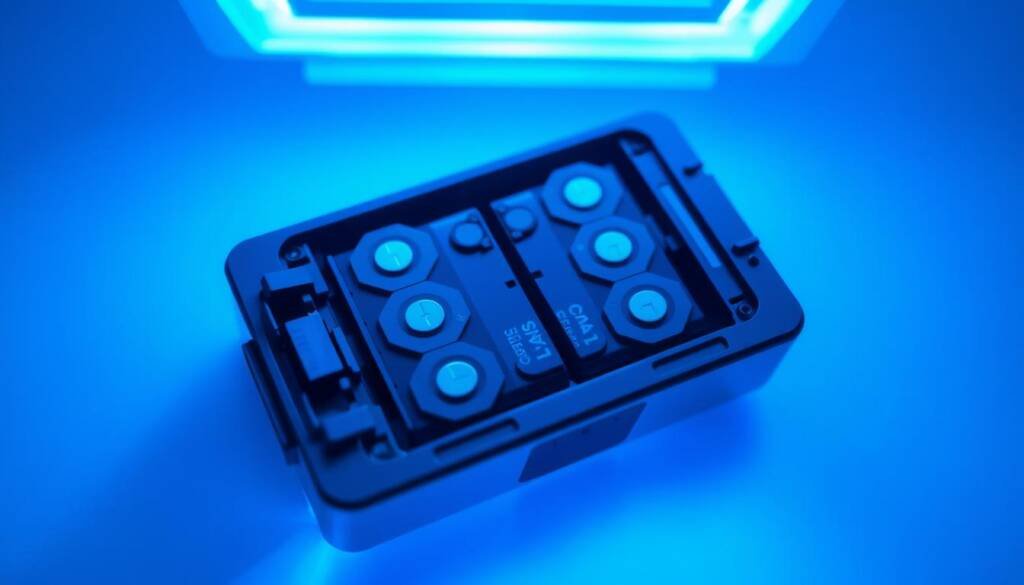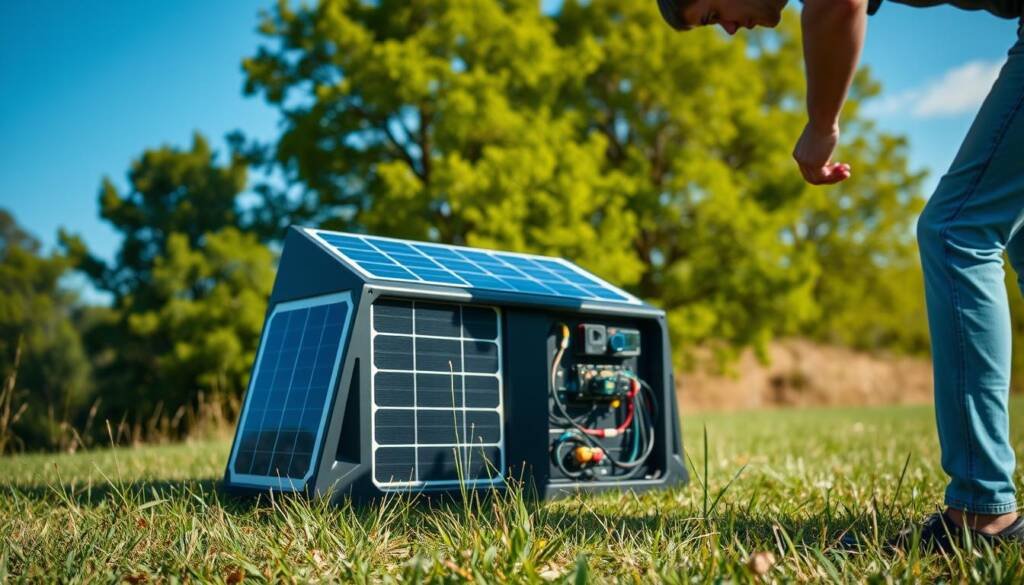Did you know that a single mistake with your portable power station could lead to instant damage? In a recent incident, connecting a solar panel with incompatible voltage to an Anker C300 resulted in immediate failure. This stark example underscores the critical need for proper portable power station maintenance and usage.
Portable power stations have become indispensable for outdoor enthusiasts and those preparing for emergencies. These versatile devices, typically weighing 20 pounds or more, pack a punch with capacities ranging from 200 watt-hours to an impressive 5,000 watt-hours. But with great power comes great responsibility.
In this guide, we’ll explore essential tips on how to maintain a portable power station and crucial battery maintenance practices. Our goal is to help you maximize the lifespan and efficiency of your power station, whether you’re using it for camping trips or as a backup during unexpected blackouts.
Understanding the capabilities and limitations of your portable power station is key. For instance, a 700-watt-hour unit can keep a refrigerator running for about 14.5 hours during a power outage. This knowledge can be crucial in emergency situations, ensuring you make the most of your device’s capacity.
Key Takeaways
- Proper voltage matching is crucial to prevent damage to your portable power station
- Regular maintenance extends the lifespan of your power station
- Understanding your device’s capacity helps in emergency planning
- Solar panel compatibility varies among different power station models
- User errors, like incorrect voltage input, are typically not covered by warranty
- Weight and capacity are important factors when choosing a portable power station
Understanding Portable Power Stations
Portable power stations are versatile energy solutions that provide on-the-go power for various devices. These compact units combine rechargeable batteries, inverters, and charging ports to deliver reliable power when you need it most.
What is a Portable Power Station?
A portable power station is a rechargeable battery pack with built-in AC outlets and DC ports. It typically uses lithium-ion or LiFePO4 batteries, which can last up to six times longer than traditional ones. These power stations can run small appliances and charge multiple devices simultaneously, making them ideal for camping, emergencies, or remote work.
Key Features to Look For
When choosing a power station, consider these important features:
- Battery capacity (measured in watt-hours)
- Output wattage
- Charging options (solar, AC, car)
- Number and types of ports
- Weight and portability
Benefits of Using a Portable Power Station
Portable power stations offer numerous advantages over traditional generators. They’re quieter, emit no fumes, and are safe for indoor use. Many models support solar charging, providing an eco-friendly power option. With recharging tips and proper care, these stations can last 500 to 2000 cycles, retaining 70-80% of their original capacity. For power station troubleshooting and maintenance, refer to the manufacturer’s guidelines to ensure optimal performance and longevity.
Essential Safety Precautions
Portable power stations are vital tools for 60% of outdoor enthusiasts and emergency preparedness users. To ensure safe and efficient use, following key precautions is crucial. Let’s explore the essential steps to keep your power station in top condition.
Read the Manufacturer’s Instructions
The user manual is your go-to guide for safe operation. It contains specific information about charging cycles, power outputs, and maintenance practices. Following these guidelines can improve charging efficiency by up to 25%. Remember, each power station model has unique features, so always refer to your specific user manual.
Inspect Before Use
Regular inspections can prevent 15% of device failures. Before each use, check for visible damage, loose connections, or signs of wear. Pay special attention to cables and ports, as using incompatible or damaged cables can lead to overheating in 5% of cases. Proper maintenance and inspection can extend your power station’s lifespan by 30%.
Use in Well-Ventilated Areas
While portable power stations don’t produce harmful exhaust gases, using them in well-ventilated spaces is still important. This practice helps prevent overheating, which can occur in 30% of overloading cases. Good ventilation also ensures optimal performance and longevity of your device. For safe storage, keep your power station in a cool, dry place away from direct sunlight and heat sources.
- Charge between 50-61% before long-term storage
- Recharge every 3-6 months when not in use
- Clean exterior and vents regularly
- Use original charger for proper voltage and current
By following these safety precautions, you’ll maximize the lifespan and reliability of your portable power station, ensuring it’s ready when you need it most.
Proper Usage Guidelines
Understanding how to use your portable power station correctly is crucial for its longevity and performance. By following these guidelines, you’ll ensure optimal runtime and prevent potential damage to your device.
Know Your Device’s Limits
Portable power stations have specific capacity limits, typically measured in watt-hours (Wh). A 300Wh unit can power a 60W laptop for about 5 hours. Check your device’s specifications and calculate power needs carefully. This knowledge is key for runtime optimization.
Avoid Overloading the Power Station
Exceeding your power station’s wattage limits can lead to overheating or permanent damage. Most units offer multiple outlets, including AC, USB, and DC ports. Be mindful of the total power draw when using multiple devices simultaneously.
Plugging and Unplugging Safely
Always use compatible accessories and follow proper procedures when connecting devices. Unplug equipment when not in use to conserve energy. Regularly inspect cables for wear and tear to prevent electrical hazards.
To maximize your power station’s lifespan, avoid deep discharges and overcharging. Recharge when the battery level drops to 20-30%, and store at about 50% capacity. By balancing power usage across devices and prioritizing essential equipment, you’ll achieve better runtime optimization and accessory compatibility.
Storage Recommendations
Proper storage is key to extending the life of your portable power station. By following safe storage practices and regular battery maintenance, you can keep your device in top shape for years to come.
Keep it Dry and Clean
Store your power station in a cool, dry place away from direct sunlight and humidity. Moisture can damage internal components, so it’s crucial to protect your device from the elements. Clean it regularly with a soft, dry cloth to remove dust and debris.
Optimal Temperature Ranges
Most power stations work best between 32°F and 104°F (0°C to 40°C). For long-term storage, aim for temperatures between 50°F and 77°F (10°C to 25°C). Extreme heat or cold can harm battery life, so avoid storing your device in attics, garages, or outdoor sheds.
Regular Maintenance Checks
Perform battery maintenance every three months during long-term storage. Discharge the battery to about 40-50% capacity before storing, and recharge it to this level every quarter. This practice helps maintain battery health and prevents capacity loss over time.
- Check for physical damage or swelling
- Clean connectors and ports
- Test all functions briefly
- Update firmware if available
By following these storage recommendations, you’ll ensure your portable power station remains reliable and ready for use whenever you need it. Remember, proper care can extend your device’s lifespan up to 10-15 years, making it a worthwhile investment for your power needs.
Charging Precautions
Proper charging is key to maintaining your portable power station’s performance and longevity. Let’s explore some essential recharging tips to keep your device in top shape.
Use the Correct Charger
Always use the charger that came with your power station. Using incompatible chargers can lead to inefficient charging or damage your device. AC outlets provide faster charging compared to car outlets or solar panels.
Monitor Charging Times
Keep an eye on your power station while it’s charging. Overcharging can harm the battery. Most units take 4-8 hours to fully charge via AC outlet. Solar charging times vary based on weather conditions.
Avoid Charging on Flammable Surfaces
Choose a cool, dry place to charge your power station. Avoid direct sunlight and flammable materials. This precaution prevents overheating and ensures safety.
Remember, proper battery maintenance extends your power station’s lifespan. Regular checks and following these charging guidelines can keep your device running for 500 to 2000 cycles. Some models with lithium iron phosphate batteries can last even longer.
- Keep the battery level above 20% to prevent deep discharges
- Store in a cool place away from direct sunlight
- Use compatible cables and adapters
- Charge to 100% every few months if not in regular use
By following these recharging tips and practicing good battery maintenance, you’ll ensure your portable power station remains a reliable energy source for all your needs.
Battery Safety

Battery safety is crucial for portable power stations. Understanding how to maintain and store your battery properly can extend its life and ensure safe operation. Let’s explore key aspects of battery safety to help you get the most out of your power station.
Recognizing Signs of Battery Damage
Keep an eye out for signs of battery damage. Swelling, unusual heat, or decreased capacity are red flags. If you notice any of these, stop using the power station immediately. Regular battery maintenance checks can identify issues in about 25% of portable power stations, allowing for timely repairs.
Proper Battery Disposal Techniques
When it’s time to replace your battery, proper disposal is essential. Never throw batteries in the trash. Instead, recycle them at designated facilities. This not only protects the environment but also complies with local regulations. Many electronics stores offer battery recycling services.
Storage and Transport Considerations
Safe storage is key to maintaining your power station’s battery health. Store your device in a cool, dry place away from direct sunlight. The ideal storage temperature range is between 40°F and 77°F. For long-term storage, keep the battery at 40-60% capacity and recharge it every three months. These safe storage practices can extend your battery’s health by.
When transporting your power station, ensure it’s well-protected from impacts and extreme temperatures. Following these guidelines for battery maintenance and safe storage will help maximize your portable power station’s lifespan and performance.
Emergency Procedures
Power station troubleshooting can be daunting, but knowing how to handle emergencies is crucial. Let’s explore key procedures to keep you safe when using your portable power station.
Dealing with Malfunctions
If your power station emits strange noises or feels hot, stop using it right away. Give it time to cool down. Check for blocked vents and clean them to improve airflow. Regular checks help prevent most issues, but stay prepared for unexpected problems.
Tackling Overheating
Overheating is a common issue. Ensure proper ventilation around your device. If it gets too hot, power it down immediately. Remember, the Jackery Solar Generator 3000 Pro can run a 500W refrigerator for about 5.1 hours, but overheating can reduce this time.
Fire Safety Measures
Keep a fire extinguisher nearby when using your power station. Learn how to use it properly. Create an evacuation plan with at least two exit routes. For every 20 people, assign one evacuation warden. Practice your plan every three months to stay prepared.
Safe storage is key to preventing emergencies. Store your power station in a dry, cool place away from flammable materials. Regularly inspect for damage or wear. By following these steps, you’ll be ready to handle any situation that arises with your portable power station.
Outdoor Usage Tips

Using your portable power station outdoors requires careful consideration to ensure optimal performance and safety. Proper usage can enhance runtime optimization and extend the life of your device.
Choosing Safe Locations
Select a dry, level surface away from water sources for your power station. Avoid direct sunlight to prevent overheating. Place it on a stable platform to reduce vibration and potential damage.
Weather Considerations
Extreme temperatures affect battery performance. In cold weather, battery drain increases, so check levels frequently. Hot conditions can degrade components, so keep your unit cool. Aim to use your power station between 32°F and 104°F for best results.
Using Under Tents and Canopies
When camping, place your power station under a shelter for protection. Ensure proper ventilation to prevent overheating. Keep the area around the unit clear for air circulation. This setup supports accessory compatibility and efficient operation.
- Maintain charge between 20% and 80% for optimal battery life
- Clean solar panels regularly with a soft brush and water
- Inspect connections periodically to avoid power loss
- Use solar panels for continuous charging on longer trips
By following these tips, you’ll maximize your power station’s efficiency and lifespan outdoors. Remember to balance protection from elements with proper ventilation for safe and reliable power during your adventures.
Multi-Device Charging Best Practices
Charging multiple devices efficiently is key to getting the most out of your portable power station. Smart charging practices can lead to better runtime optimization and improved accessory compatibility.
Prioritizing Device Charging
When faced with multiple devices, charge essential items first. Start with your phone or emergency communication devices. Next, power up laptops or tablets. Leave less critical gadgets for last. This approach ensures you always have access to vital communication tools.
Understanding Port Limitations
Portable power stations come with various ports, each with its own power output. USB ports typically deliver less power than AC outlets. Check your device’s power requirements and match them to the appropriate port. This strategy maximizes charging efficiency and prevents overloading.
Using Compatible Accessories
The right accessories can make a big difference in charging performance. Use manufacturer-recommended cables and adapters for the best results. These accessories are designed for optimal power transfer and can enhance runtime optimization. Avoid cheap, off-brand alternatives that might compromise charging speed or safety.
Before plugging in, always check your devices’ wattage. Make sure the total doesn’t exceed your power station’s capacity. This simple step prevents overloading and ensures safe, efficient charging for all your gear.
Eco-Friendly Practices

Embracing eco-friendly practices with portable power stations not only extends their lifespan but also contributes to a greener future. By adopting sustainable habits, we can maximize the benefits of these innovative energy solutions while minimizing our environmental impact.
Energy Conservation Tips
To optimize your portable power station’s efficiency, follow these energy-saving strategies:
- Unplug devices when fully charged
- Use energy-efficient appliances
- Implement solar charging when possible
- Monitor power consumption regularly
Proper battery maintenance is crucial for longevity. Keep your power station clean, store it at room temperature, and perform regular check-ups to ensure optimal performance.
Recycling Old Power Stations
When your power station reaches the end of its life, responsible recycling is key. Many manufacturers offer recycling programs as part of their warranty information. Check with your local e-waste facility for proper disposal methods to recover valuable materials and reduce environmental impact.
Sustainable Usage Habits
Develop sustainable habits to maximize your power station’s efficiency:
- Utilize renewable energy sources for charging
- Plan power usage to avoid unnecessary drain
- Educate others on eco-friendly power practices
By integrating these practices, we can extend the life of our portable power stations and contribute to a more sustainable energy future.
Final Thoughts on Safety
As we wrap up our guide on portable power station safety, it’s crucial to recap key points that ensure both your safety and the longevity of your device. Always consult your user manual for specific instructions and check warranty information before use. Remember, a well-maintained LiFePO4 battery station can last up to 10 years, significantly outperforming traditional lithium-ion models.
Recap of Key Safety Tips
Prioritize regular inspections, use in ventilated areas, and avoid overloading. During emergencies like Hurricane Helene, which left 2.6 million without power, knowing your device’s limits is critical. The Jackery Solar Generator 1000 V2, for instance, can power a 60W refrigerator for 15 hours, helping keep food safe during outages.
Encouraging Safe Practices
Adopt safe charging habits and proper storage techniques. The EcoFlow Delta Max’s ability to power a 120W refrigerator for up to 28 hours showcases the importance of choosing the right capacity for your needs. Always follow manufacturer guidelines and dispose of batteries responsibly to protect both yourself and the environment.
Future Trends in Portable Power Technology
Looking ahead, we’re seeing advancements in capacity and charging speeds. The Anker Solix F3800, with its 3840Wh capacity and 6000W output, hints at a future where portable stations could serve as whole-home backup systems. As technology evolves, staying informed about safety features and adhering to best practices will be key to maximizing the benefits of these innovative power solutions.